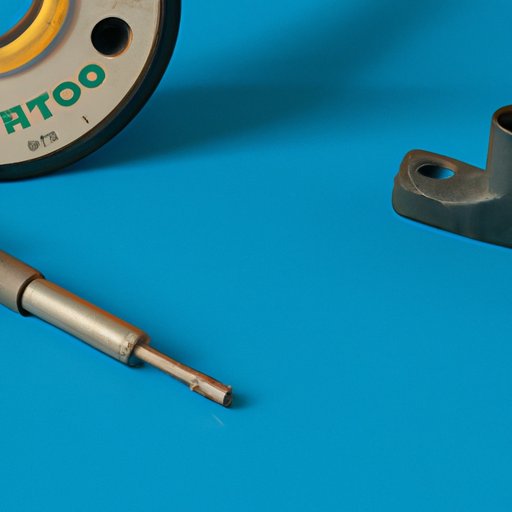Introduction
Micrometers are precision tools used to take extremely accurate measurements. They are commonly used in fields such as engineering, manufacturing, and science. Even if you are not a professional in these fields, knowing how to read a micrometer can come in handy for DIY projects or for simple tasks like measuring the thickness of a piece of paper. In this article, we will provide a step-by-step guide to reading a micrometer. We will also cover common mistakes and offer tips for improving your proficiency with this tool. Let’s get started!
Step-by-Step Guide to Reading a Micrometer
Before we start, it is important to note that micrometers come in different types, such as an inside micrometer, outside micrometer, and depth micrometer. For this guide, we will focus on the outside micrometer, which is the most common type. Here are the steps to follow:
Step 1: Hold the tool properly
The first thing to consider is how to hold the micrometer properly. Grip it firmly but without applying excessive force. Always use the tips of your fingers and not the pads of your fingers, as this can cause difficulty in controlling the micrometer. It is also important to make sure that your hands and the micrometer are dry and clean to prevent slippage.
Step 2: Achieve the Correct Level of Light
To read the measurements properly, it is essential to have good lighting. You can position the micrometer under a lamp or a bright light source to ensure that you can see the measurements clearly. Avoid direct sunlight or glare on the micrometer, as this can make it difficult to read the measurements.
Step 3: Position the Reading Line
The next step is to position the reading line correctly. The reading line is the line or mark on the sleeve that aligns with the thimble. To position the line, close the micrometer jaws and rotate the thimble until the line coincides with the zero mark on the sleeve.
Step 4: Using the Thimble and Sleeve to Take Measurements
Taking measurements with a micrometer requires a little bit of practice, but once you get the hang of it, it becomes easier. Open the jaws of the micrometer by turning the thimble away from the sleeve. Position the micrometer on the object you want to measure and then close the jaws until they are snug against the object. Hold the micrometer steady and read the measurement on the sleeve and thimble. Be sure to read both the sleeve and thimble to get an accurate measurement.
Step 5: Interpreting the Reading
Interpreting the reading is the most critical step in using a micrometer. To read the measurement, start with the largest unit on the sleeve and then move on to the smallest unit on the thimble. For instance, if the reading on the sleeve is 4 and the reading on the thimble is 0.48, the overall measurement is 4.48mm.
Video Tutorial
While written instructions can be helpful, hands-on learning is often the best way to understand how to read a micrometer. Watching a video tutorial that demonstrates how to use a micrometer can be incredibly useful. In this tutorial, you will see close-up shots of a micrometer in action and a step-by-step demonstration of how to read a micrometer.
Common Mistakes
Reading a micrometer can be challenging, especially if you’re a beginner. Here are some common errors people make when reading a micrometer:
- Not holding the micrometer steady
- Reading the measurements incorrectly
- Using the wrong scales on the sleeve and thimble
To avoid these mistakes, make sure to practice reading the measurements multiple times and try to take measurements on different objects. This will help you to become more familiar with the tool and avoid common errors when measuring accurately.
DIY Projects with Micrometers
Micrometers are precision tools that can benefit any DIY project that requires measurements with a high degree of accuracy. Here are some examples of DIY projects that require precision measurements:
- Woodworking projects
- Metalworking projects
- Crafts
- Science experiments
To use the micrometer for these projects, follow the steps listed above and try to be as precise as possible. This can help you to ensure that your DIY project turns out perfectly.
Troubleshooting and Resolving Minor Issues
Even if you are comfortable with using a micrometer, you may still encounter some issues when taking measurements. Here are some common issues and tips on how to fix them:
- “Sticking” jaws: Clean the micrometer with a dry cloth or replace a damaged micrometer.
- Inaccurate readings: Check to make sure that the micrometer is calibrated correctly, clean the micrometer, and try taking measurements again in good lighting.
If you are still having problems, you may need to seek professional assistance.
Conclusion
In conclusion, reading a micrometer can be a bit daunting at first, but with practice and patience, it becomes easier to do accurately. Always hold the micrometer properly, position the reading line correctly, and interpret the measurements using the right scales on the sleeve and thimble. Remember to avoid common mistakes and always check the measurements multiple times to ensure accuracy. And with the tips provided in this article, you can be confident in your ability to read a micrometer and take accurate measurements.
